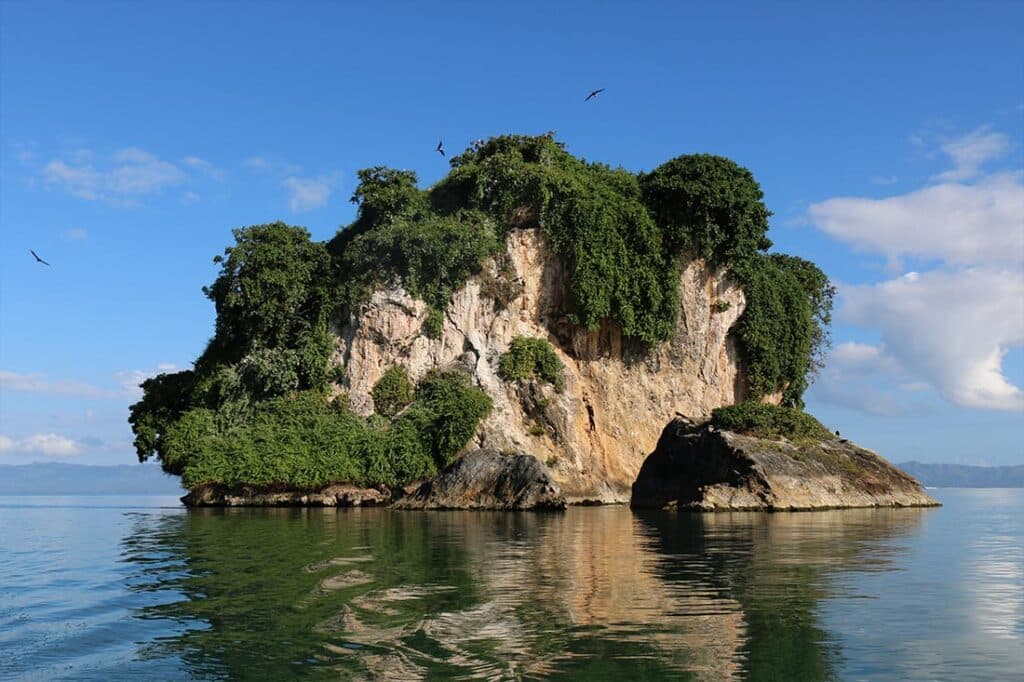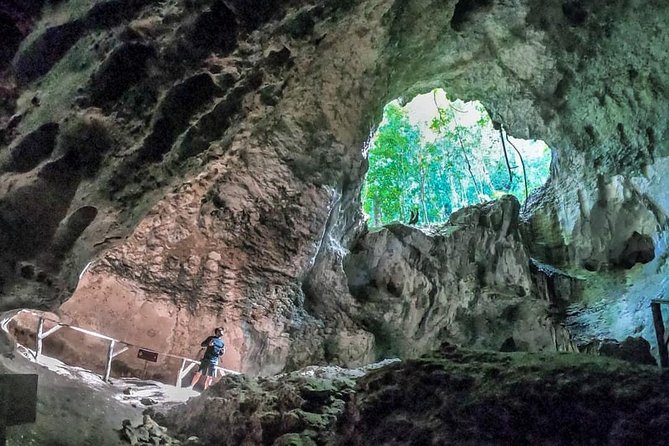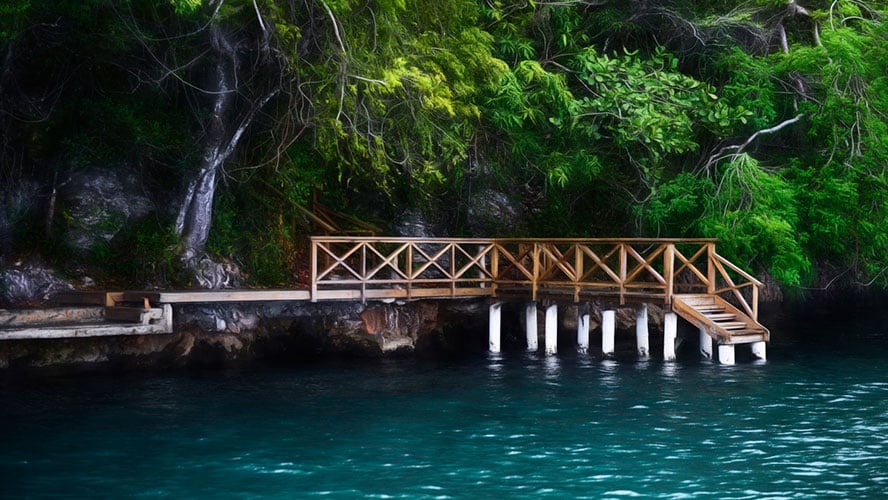Discovering Los Haitises National Park
Tucked away on the northeastern coast of the Dominican Republic, Los Haitises National Park remains one of the country’s best-kept secrets. This untamed paradise stretches across over 800 square kilometers of protected land and sea, nestled between the waters of Samaná Bay and the lush, rolling hills of the interior.
What sets Los Haitises apart isn’t just its dramatic beauty—it’s the park’s ability to transport you to another world. Towering limestone karsts rise from emerald mangrove estuaries, creating a surreal seascape best explored by boat or kayak. Inside hidden caves, ancient Taino petroglyphs whisper stories of the island’s indigenous past. And all around, a thriving ecosystem hums with life—from elusive manatees gliding beneath the surface to tropical birds soaring overhead. Whether you’re an eco-traveler, a history buff, or simply seeking tranquility off the beaten path, Los Haitises offers a deep dive into the wild heart of the Caribbean.
Your Gateway to the Park
Though Los Haitises National Park feels worlds away from modern life, reaching this unspoiled haven is easier than it seems, provided you know where to begin. The park is accessible from two main gateways: the coastal town of Samaná and the quieter village of Sabana de la Mar. Both offer unique entry points and experiences, depending on the direction from which you approach the park.
From Samaná, travelers can book organized boat tours departing from the city’s vibrant marina. These excursions often include knowledgeable local guides who navigate the mangrove channels and caves, weaving in ecological facts and folklore. For those coming from Sabana de la Mar, access to the park is more direct and generally less crowded. Here, you can arrange private boat rides or join smaller group tours, offering a more intimate encounter with the park’s natural wonders.
If you’re staying in the region, consider eco-lodges such as Paraiso Caño Hondo, which not only provide rustic comfort and sweeping views of the jungle but also offer guided tours right from their doorstep. These accommodations are particularly convenient for travelers seeking an immersive experience without the hassle of day-tripping.
The best time to visit Los Haitises is between December and April, when the weather is drier and the sea is calm, ideal for boat navigation and wildlife viewing. However, visiting during the green season (May to November) has its perks too: fewer tourists, lush vegetation, and a quieter, mistier atmosphere that enhances the park’s mystical charm. Just be prepared for occasional rain and plan activities accordingly.
What to See?
The diverse landscape of Los Haitises offers a rich tapestry of natural features and ecological marvels, each revealing a different facet of the park’s unique character. From coastal wetlands to limestone cliffs, and ancient rock art to vibrant bird colonies, the park invites discovery in every direction. Below are the key highlights that define the essence of this extraordinary environment.
Mangrove Forests
Los Haitises National Park is home to one of the largest and most pristine mangrove ecosystems in the Caribbean. These dense forests line the coastal inlets and estuaries, their tangled roots submerged in brackish water. The mangroves serve as vital breeding grounds for marine life and play a crucial role in protecting the coastline from erosion. Exploring the area by boat reveals a labyrinth of water channels, shaded by arching branches and alive with the sound of birds and the splash of hidden creatures.
Karst Formations
The park’s dramatic landscape is shaped by karst topography—limestone formations carved by millennia of water and wind erosion. Towering mogotes rise abruptly from the flat wetlands, while sinkholes, underground rivers, and rugged hills dominate the interior. These geological features create a surreal, almost cinematic backdrop, offering a striking contrast between the solid stone and the vibrant plant life clinging to its surfaces.
Caves with Petroglyphs
Beneath the surface of Los Haitises lie numerous caves that once served as sacred spaces for the indigenous Taíno people. Among the most well-known are Cuevas de la Arena and San Gabriel, both accessible by guided boat tours. Inside, visitors can view petroglyphs and pictographs etched into the walls—symbolic expressions of a culture that predates European contact. The caves are not only archaeological sites but also atmospheric chambers of silence, shadow, and history.
Wildlife Highlights
The biodiversity of Los Haitises is one of its most defining attributes. The park provides a haven for a wide range of animal species, many of which are endemic to the island of Hispaniola. Manatees glide quietly through the coastal waters, while brown pelicans nest on rocky outcrops along the shoreline. The forest canopy is home to owls and parrots, and the wetlands attract herons, ibis, and other wading birds. The park also shelters rare amphibians, reptiles, and invertebrates, many found nowhere else in the world.
Adventures & Activities
The experience of Los Haitises is defined not just by what you see, but by how you choose to explore it. The park’s varied terrain and rich biodiversity invite a range of immersive activities that reveal its natural rhythms from multiple perspectives. Whether by water, on foot, or through cultural exchange, each adventure offers a new way to connect with the landscape and its living heritage.
Kayaking and Boat Excursions
Exploration of Los Haitises often begins on water. Kayaking offers an immersive experience, allowing travelers to drift silently through shaded mangrove channels, beneath low-hanging branches, and past hidden coves. In contrast, boat excursions provide broader access to the park’s scattered limestone islets and significant landmarks, including ancient cave systems and seabird colonies. Both modes of travel reveal the park’s intricate connection between land and sea.
Forest Trails and Inland Hikes
While water dominates the landscape, portions of the park are accessible by land. A network of forest trails winds through dense vegetation and karst terrain, guiding visitors into the park’s humid interior. These walks traverse biodiverse ground, crossing under tall tree canopies and around natural rock formations. Paths are typically short and moderate in difficulty, offering opportunities to observe endemic plant life and subtle shifts in habitat.
Avian Observation and Bird Habitats
Los Haitises is a sanctuary for birdlife, its varied environments sustaining both endemic and migratory species. Designated observation points near coastal cliffs, riverbanks, and forest edges provide clear sightlines for spotting birds such as the white-crowned pigeon, pelicans, the barn owl, and the Hispaniolan oriole. The park’s role in bird conservation draws interest from ornithologists and casual watchers alike.
Community-Based Eco and Cultural Tours
Several communities bordering the park engage in eco-tourism as a form of environmental stewardship and cultural expression. Guided experiences led by residents introduce visitors to traditional farming techniques, folklore, and the medicinal uses of native flora. These programs integrate ecological education with cultural exchange, fostering a deeper awareness of how local life and landscape are intertwined.
Where to Stay: From Eco-Lodges to Rustic Retreats
Staying near Los Haitises National Park offers a chance to remain immersed in nature beyond daytime exploration. A growing number of eco-lodges and rustic retreats provide accommodations that emphasize sustainability, simplicity, and a close relationship with the surrounding landscape. Most lodgings are located in or near Sabana de la Mar and Samaná, with options ranging from elevated cabins overlooking the forest to riverside guesthouses that operate on solar power and local labor. When choosing where to stay, travelers should consider factors such as accessibility to the park, community involvement, environmental practices, and the type of experience they wish to have—whether quiet seclusion, wildlife proximity, or cultural interaction.
| Accommodation | Location | Type | Pros | Cons |
| Paraíso Caño Hondo | Near Sabana de la Mar | Eco-lodge | On-site natural pools, guided tours, and jungle immersion | Remote, limited cell service |
| Altos de Caño Hondo | Hill above Caño Hondo | Boutique eco-lodge | Elevated views, renewable energy use, and birdwatching decks | Steep climb; not ideal for mobility-limited travelers |
| El Valle Lodge | Near Samaná | Jungle lodge | Close to beaches, supports reforestation programs | Further from park by boat |
| Hotel Select | Sabana de la Mar | Budget guesthouse | Affordable, walkable town center access | Minimal eco-features; basic comfort |
| The Dominican Tree House Village | Samaná area | Elevated cabins | Unique treetop stay, open-air design, local meals | Not directly near the park |
| Rincón Ecolodge | El Rincón, Samaná | Rustic ecolodge | Family-run, organic garden, supports local employment | Limited English spoken; seasonal availability |
| Hostal D’Francis | Sabana de la Mar | Guesthouse | Warm hospitality, short distance to the dock | Urban setting; limited nature immersion |
| Private Farm Stays | Surrounding region | Agritourism lodging | Quiet retreats, hands-on cultural experiences | Require advanced coordination and limited amenities |
Tips for Travelers
A journey to Los Haitises National Park offers a raw and immersive experience in nature, but preparation and awareness of local practices are key to making the most of the adventure. From practical packing to mindful conduct, here are essential tips to guide your visit.
What to Pack?
The park’s environment is humid, tropical, and at times unpredictable. Equipping yourself with the right items ensures comfort and readiness throughout the trip.
- Mosquito repellent (preferably DEET-free and eco-safe)
- Lightweight, long-sleeved clothing for sun and insect protection
- Waterproof jacket or poncho for sudden rain showers
- Closed-toe hiking shoes with grip for slippery terrain
- Dry bags for electronics and valuables during boat rides
- Reusable water bottle to stay hydrated and reduce plastic use
- Binoculars and a camera for birdwatching and landscape photography
Local Customs and Etiquette
Visitors are encouraged to respect the cultural and social norms of the region, particularly when interacting with local communities near the park.
- Greet locals with a friendly “buenos días” or “buenas tardes”
- Dress modestly when entering towns or participating in community-led tours
- Avoid photographing individuals without permission
- Support locally-owned businesses and community initiatives whenever possible
Environmental Considerations
Preservation of Los Haitises depends on responsible tourism. The park is ecologically sensitive and supports many rare and endangered species.
- Stay on marked trails and avoid disturbing wildlife
- Do not litter; bring a bag for personal trash if facilities are limited
- Use reef-safe sunscreen and biodegradable personal products
- Avoid loud noises that may disrupt animal habitats
- Refrain from collecting plants, shells, or rocks as souvenirs
A Journey into the Heart of Nature
In a world where wild spaces are increasingly rare, Los Haitises National Park stands as a living sanctuary, untouched, intricate, and deeply rooted in history. Its mist-covered karst towers, secretive mangrove tunnels, and ancient cave art remind us that nature, when preserved, offers more than beauty; it offers perspective. Here, time slows. The calls of birds echo across the water, the rainforest breathes with quiet rhythm, and the stories of the Taíno remain etched in stone.
To walk its trails, to glide along its waterways, is to connect not only with the natural world, but with a way of life that values harmony between people and place. Every rustling branch, every distant wingbeat, is part of a delicate ecosystem that still thrives—thanks in part to those who visit with care and leave with reverence.
As travelers, we are not merely observers. We are stewards. A visit to Los Haitises is an invitation not just to witness something extraordinary, but to protect it. Its preservation depends on those who choose the slower route, the quieter path, and the more thoughtful journey. May each step taken through this park echo with a commitment to its future, and may its untouched wonders endure for generations to come.












